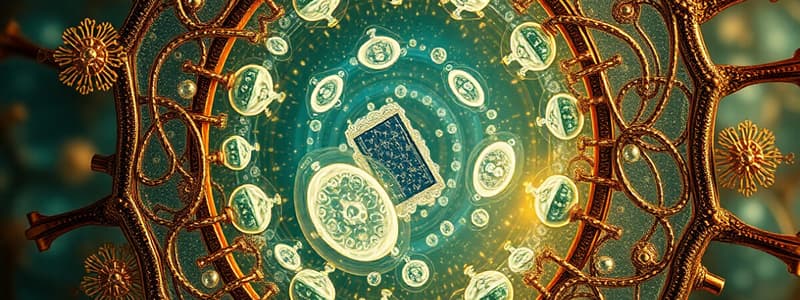Podcast
Questions and Answers
What did Robert Hooke call the tiny compartments he observed in cork?
What did Robert Hooke call the tiny compartments he observed in cork?
- Organs
- Atoms
- Cells (correct)
- Tissues
The layer of the onion that is used for observation is called the epidermis.
The layer of the onion that is used for observation is called the epidermis.
True (A)
What solution is applied to the onion peel during the preparation for observation?
What solution is applied to the onion peel during the preparation for observation?
Safranin solution
Robert Hooke made his observation of cells in the year __________.
Robert Hooke made his observation of cells in the year __________.
Match the parts of a compound microscope with their functions:
Match the parts of a compound microscope with their functions:
What type of microscope did Robert Hooke use to make his observations?
What type of microscope did Robert Hooke use to make his observations?
The structures observed in the onion peel are distinct and do not resemble each other.
The structures observed in the onion peel are distinct and do not resemble each other.
What is the purpose of using a drop of water on the microscope slide?
What is the purpose of using a drop of water on the microscope slide?
Who first discovered cells and published his findings in 1665?
Who first discovered cells and published his findings in 1665?
The cell theory states that cells are the basic unit of life in both plants and animals.
The cell theory states that cells are the basic unit of life in both plants and animals.
What did Robert Brown discover in 1831?
What did Robert Brown discover in 1831?
The fluid substance in a cell was named __________ by Purkinje in 1839.
The fluid substance in a cell was named __________ by Purkinje in 1839.
What term is used for organisms made up of a single cell?
What term is used for organisms made up of a single cell?
Match the following scientists with their respective discoveries:
Match the following scientists with their respective discoveries:
With the discovery of the electron microscope in 1940, we could no longer observe the complex structure of the cell.
With the discovery of the electron microscope in 1940, we could no longer observe the complex structure of the cell.
Name one unicellular organism.
Name one unicellular organism.
Study Notes
Discovery of Cells
- Robert Hooke first observed cells in cork in 1665 using a self-designed microscope.
- The term "cell" is derived from the Latin word meaning 'little room', reflecting the honeycomb-like structure seen in cork.
- This observation marked a significant moment in scientific history, identifying that living organisms consist of distinct units.
Characteristics of Living Organisms
- Living organisms are made up of cells, which are the basic building units of life.
- A simple experiment using onion peel demonstrates that cells are uniform in structure despite originating from bulbs of different sizes.
Microscopy and Cell Observation
- A compound microscope is used to observe cells by preparing temporary mounts of onion peel.
- The process involves placing the peel in water, adding a dye (safranin), and observing under magnification.
- Different cells from the same organism exhibit similar structure, emphasizing the fundamental nature of cells.
Historical Context of Cell Discovery
- Anton van Leeuwenhoek observed free-living cells in pond water in 1674, providing insights into unicellular organisms.
- In 1831, Robert Brown discovered the nucleus within the cell, furthering the understanding of cell structure.
- The term 'protoplasm' was introduced by Purkinje in 1839, referring to the fluid substance of the cell.
- The cell theory, established by Schleiden and Schwann in 1838-1839, posits that all organisms are composed of cells and that cells are the fundamental life unit.
- Virchow expanded this theory in 1855 by stating that all cells originate from pre-existing cells.
Unicellular vs Multicellular Organisms
- Organisms can be categorized as unicellular (single-celled, e.g., Amoeba, Chlamydomonas, Paramecium, bacteria) or multicellular (many-celled, e.g., fungi, plants, animals).
- Each multicellular organism develops from a single cell that divides to form more cells.
Experimental Activities
- Suggested activities include preparing temporary mounts of various plant peels to observe cell structures.
- Key questions arise regarding the uniformity of shape, size, and structure of cells from different organisms.
Important Terms
- Unicellular Organisms: Entities consisting of a single cell.
- Multicellular Organisms: Entities composed of multiple cells that perform varying functions within a single body.
- Cell Theory: The foundational concept that all living things are made of cells and that cells arise from existing cells.
Studying That Suits You
Use AI to generate personalized quizzes and flashcards to suit your learning preferences.
Description
Explore the groundbreaking discovery of cells by Robert Hooke in 1665. This quiz delves into the structure of cork and how it resembles a honeycomb, leading to the understanding of cells as the fundamental units of life. Test your knowledge on this pivotal moment in biology.




